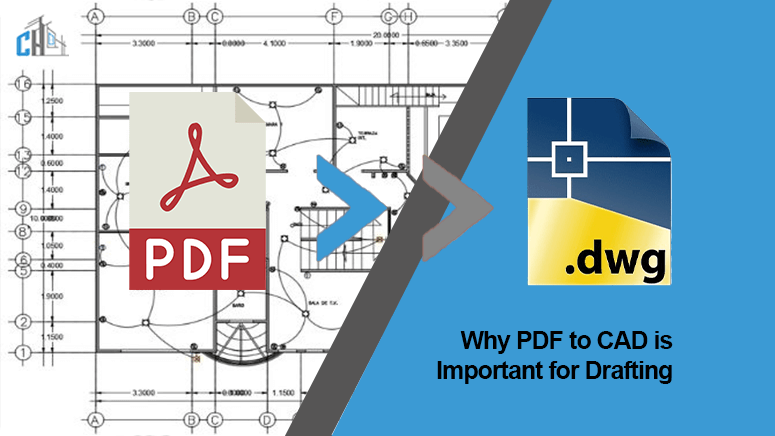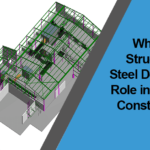Over the past few years, PDF to CAD conversion has become a standard practice in the Architecture, Engineering, and Construction (AEC) industry, facilitated by advanced 3D CAD drawing services and sophisticated design software. It is the most important process that converts paper-based PDF files into semi-intelligent, fully editable CAD drawings.
In this blog post, we delve into the importance of converting PDF to CAD for contemporary drafting, providing valuable insights and practical advice for industry professionals.
Understanding PDF and CAD
To appreciate the significance of PDF to CAD conversion, it’s essential to understand these formats first. PDF or Portable Document Format is a format that allows documents to have a uniform appearance on any device. Because it is relatively less likely to invert or become corrupted and offers better compatibility, it is especially used in sharing architectural plans and technical drawings.
CAD, on the other hand, is an abbreviation for Computer Aided Design, which is computer software for architects, engineers, and drafters to produce accurate 2D or 3D drawings. AutoCAD and other CAD programs provide a platform for executing a design and adjusting it as desired using precise tools that cannot be found in other software.
When the PDF files are converted into CAD formats like DXF or DWG, one can fully exploit all the features of CAD software in terms of efficiency and results.
The Importance of PDF to CAD Conversion
Converting PDF drawings into CAD formats has many benefits, one among them is that it increases accuracy. PDF files may contain scanned images or raster graphics, which could be more suitable for making detailed designs. Such files can then easily be translated to a CAD format every line and measurement on the final project will be seemingly precise as intended.
In addition, CAD conversion helps with scalabilities. Unlike PDFs, CAD files can be easily changed based on the change in scale or detail of the object being drawn. Such functionality is vital for the architects and engineers who work on multiple projects and should be able to tweak it according to the present project needs.
The third major advantage is that fusion is relatively easy to edit. Compared to PDFs that cannot be edited in any way, CAD files enable very extensive changes.
This capability is an efficient design tool that minimizes the time and effort required to evolve or even amend plans. While simple adaptations affect how changes are managed, professionals handling big projects value a smooth integration of the change.
How PDF to CAD Improves Productivity
Imagine a construction firm that has various assignments that it is working on in parallel with other firms. Each project is rewritten, discussed with the client, and examined according to local regulations. With PDF to CAD conversion, this process could become manageable and convenient.
However, CAD software enables the team members to work together more efficiently by sharing and modifying designs from a central location.
The conversion process also helps to increase productivity since there is a low probability of making mistakes. Other problems that static PDF files present when dealing with them include accuracies that might be massively consequential, even when they are negligible.
CAD conversion reduces this risk in that the designers get to recognize the differences and make corrections in the design stage. This approach minimizes time and overall cost, thus leading to efficiency in the eventual delivery of the project.
In addition, Converting PDF to AutoCAD fosters better communication among stakeholders. Using CAD files, all involved in a project can open and edit the same file and share it easily with others. Such openness helps people understand something and manage more effective collaboration since all are working toward the same goal.
Also read: Benefits of Hiring a PDF to CAD Specialist Expert Help
Challenges and Solutions in PDF to CAD Conversion
Despite its benefits, PDF to CAD conversion is challenging. Sometimes, one just has to convert into another media, and this process can cause some drawings to be cut short or distorted. To overcome this, there is a need to use the proper drafting software that is capable of proper CAD conversion. Most of these tools come with additional and enhanced functions which maintain the quality of the output document.
I also know that it is not easy to handle large files since they are complex and hard to handle sometimes. Practical activities like partitioning documents into logical sections or going for cloud-based storage systems can solve this problem.
Further, acquiring appropriate hardware and software may improve the situations as the program runs and productivity to effectively address the concerns of large projects.
Last, but not least, it is also a possibility to face some learning effects if using new software or converting processes. Organizations must ensure that employees get proper training, support and material that will be useful in the implementation and exploitation of CAD technology.
Promoting the ideas of lifelong learning alongside growth will help the staff to keep up with such trends in the field and be at par with competitors.
Best Practices for PDF to CAD Conversion
To ensure successful and efficient PDF to CAD conversion, consider the following best practices:
Choose the Right Software: Spend more buying drafting software, which allows for the conversion of its Cad files. Some of the aspects to consider include batch process, vectorization, and layer management to enhance the efficiency and quality of documents produced.
Optimize File Management: Learn how to set up a system for filing your CAD files in a manner that would allow you easy access to them. Some of these solutions may be run through the cloud for easy access and distribution between departments.
Regularly Update Software and Hardware: It is recommended to keep up with the latest improvements of the tools chosen for their further use to have access to new features. Updates affect performance and compatibility with newly emerging file formats or standards, and thus, frequent updates should be encouraged.
Provide Training and Support: Getting the right skills and knowledge about the CAD conversion to your team will be very vital. A provide training sessions, Web-based classes, or contact with possible employers for employees’ professional enhancement.
By adhering to these best practices, you can maximize the efficiency and effectiveness of your PDF-to-CAD conversion efforts, ultimately enhancing your drafting capabilities.
Also read: Converting PDF to AutoCAD (DWG and DXF) – Step-by-Step Guide
Conclusion
In conclusion, Outsourcing PDF to CAD Conversion Services is an essential process for architects, engineers, and construction professionals seeking to optimize their drafting capabilities. Before summarizing the benefits of CAD conversion, discussing the challenges, and reviewing the solutions and recommendations, you will be able to improve your workflow and increase accuracy, productivity, and cooperation in your projects.
To explore the potential of PDF to CAD conversion for your work, consider reaching out to industry experts or exploring related services and products. By knowing what is going on in the CAD drafting field today, you will be in a better place to be very innovative and to stay ahead of your competition, especially given the fact that the drafting business is changing so quickly today.
At CAD Drafting, we provide expert PDF to CAD Specialist professionals and advanced PDF to CAD conversion software, ensuring high-quality and clear PDF to cad conversion services and CAD drawings. Our services are exceptional, competitively priced, and come with rapid turnaround times. To learn more about what we offer, feel free to reach out to us today.




